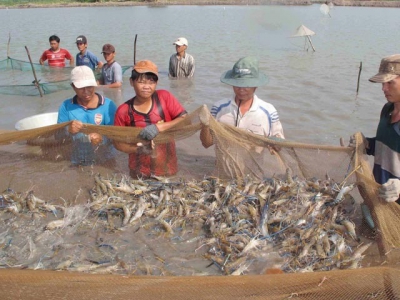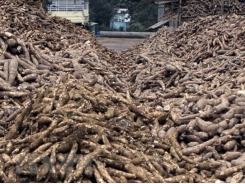Mekong Delta aims for high-quality agriculture in 2019

Ho Chi Minh City — Localities in the Mekong Delta have set ambitious targets this year with a focus on high-quality agriculture combined with eco-tourism, services and industry.
Farmers harvest shrimp in An Giang Province. Farmers in the Cuu Long (Mekong) Delta have resumed breeding of shrimp as prices are expected to increase because of exporters’ need for more raw materials. — Photo danviet
Last year, though the Delta faced unseasonable weather, flooding and a decline in agricultural product prices, the localities achieved positive socio-economic targets.
Located in a key economic region, with advantages in tourism, aquaculture and rice production, Kiên Giang Province, for instance, achieved an economic growth rate of 7.5 per cent last year.
The province’s total Gross Regional Domestic Product (GRDP) reached more than VNĐ62.3 trillion (US$2.68 billion), and budget revenue collection VNĐ9.95 trillion, 7.7 per cent higher than estimated.
Phạm Vũ Hồng, chairman of the Kiên Giang People’s Committee, said in 2018 the province created 213 large-scale fields to help farmers apply technology to rice production.
The province produced more than 4.2 million tonnes of rice in 2018. At least 76 per cent of high quality rice was exported, he said. The province’s aquaculture yielded about 815,400 tonnes, exceeding 4 per cent of the plan.
It welcomed over 7.6 million visitors, of which international visitors were 580,000, exceeding 34.8 per cent of the year’s plan, he added.
Record high
Nguyễn Văn Dương, chairman of Đồng Tháp Provincial People’s Committee, said that export turnover of the province reached a record US$1.2 billion last year, a surge of over 40 per cent compared to the previous year.
The province sent more than 2,000 people to work overseas in Japan and South Korea (the target was 1,000).
The province also focused on smart agricultural production, applying advanced technologies to ensure sustainable agriculture.
In addition, in 2018 Vĩnh Long Province achieved VNĐ10.593 trillion worth of agricultural production, according to the provincial People’s Committee.
The province’s investment environment improved with 22 new projects with total registered capital of VNĐ5.893 trillion, up by 10 projects over the same period.
The number of tourists to Vĩnh Long also increased by more than 8 per cent over the previous year.
Tiền Giang Province also achieved good results in industry, export, tourism, rice production, and fisheries, among others.
Income per capita in Tiền Giang increased to VNĐ47.6 million last year, exceeding the set target, which was higher than the average of the entire Mekong Delta region.
Ambitious targets
Lê Quang Trung, vice chairman of Vĩnh Long Provincial People’s Committee, said this year Vĩnh Long planned to improve its growth models by increasing labour productivity and competitiveness.
The province plans to enhance cooperation activities among other localities in the region to develop its trade, service and tourism sectors.
Vĩnh Long will continue to restructure agriculture with the building of new rural areas, and focus on building value chains for production and promoting major agricultural products.
The Kiên Giang Provincial People’s Committee plans to improve the quality of human resources and administrative reforms, promote investment in major transport infrastructure, and develop Phú Quốc island district as a special economic zone and driving force of the province.
Kiên Giang will also continue to restructure the agricultural sector with a focus on building new rural areas, and issue more incentives to attract investment in clean and organic agriculture.
The province will enhance investment promotion and recover delayed projects or those that have been implemented slowly.
Kiên Giang aims to achieve a growth rate of more than 7.8 per cent, the top figure in the Mekong Delta region.
In addition, Sóc Trăng will also improve its business environment and promote agricultural development with linkages to value chains, with priorities given to clean rice and aquatic products, use of high technologies, and promotion of tourism and renewable energy.
Sóc Trăng targets a growth rate of between 7.3 per cent and 7.5 per cent this year, with income per capita of more than VNĐ42 million.
It will continue to reduce the rate of poor households in the Khmer community people to 3 – 4 per cent per year.
Võ Thành Thống, chairman of Cần Thơ City People’s Committee, said Cần Thơ is playing a major role in the Mekong Delta in many fields such as education and training, healthcare, science and technology, industry, trade, services and tourism.
Cần Thơ will continue to reform its growth model, restructure the economy towards sustainable development, and promote administrative reform, as well as create more favourable conditions for local and foreign enterprises to operate effectively.
Cần Thơ will also promote a knowledge-based economy.
The Mekong Delta accounts for 12 per cent of the national area and 19 per cent of its population. It contributes 50 per cent of the rice crop, 65 per cent of aquaculture, 70 per cent of fruit, 95 per cent of exported rice and 60 per cent of exported fish.
Related news
Tools

Phối trộn thức ăn chăn nuôi

Pha dung dịch thủy canh

Định mức cho tôm ăn

Phối trộn phân bón NPK

Xác định tỷ lệ tôm sống

Chuyển đổi đơn vị phân bón

Xác định công suất sục khí

Chuyển đổi đơn vị tôm

Tính diện tích nhà kính

Tính thể tích ao



 Tiền Giang farmers rotate rice with other crops,…
Tiền Giang farmers rotate rice with other crops,…  Vietnam's cassava industry faces big hurdles
Vietnam's cassava industry faces big hurdles